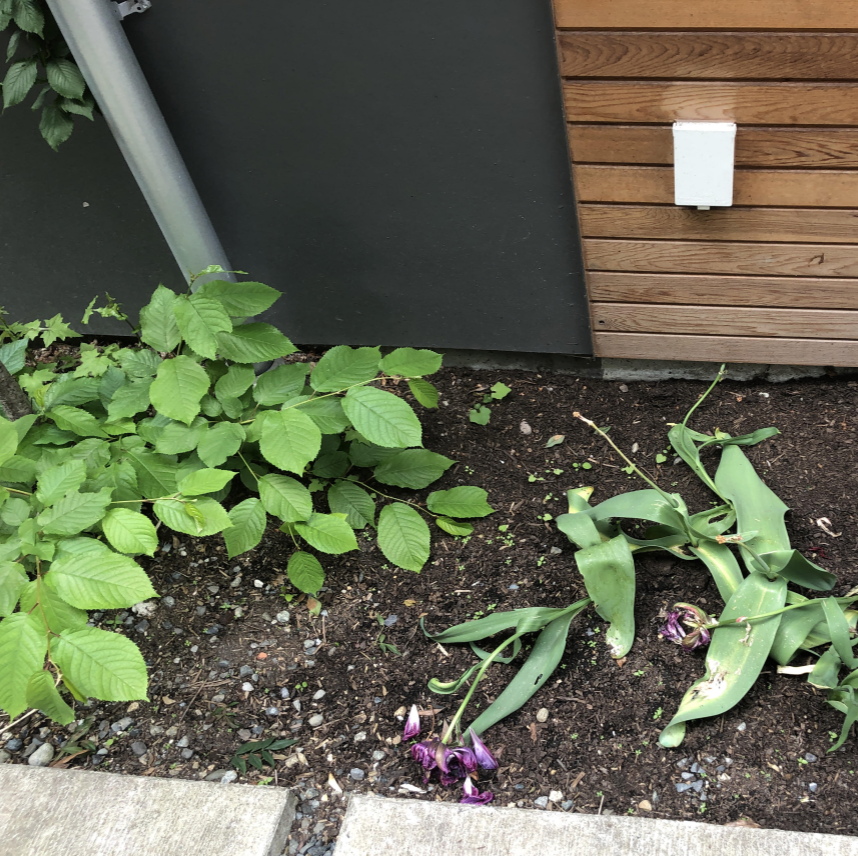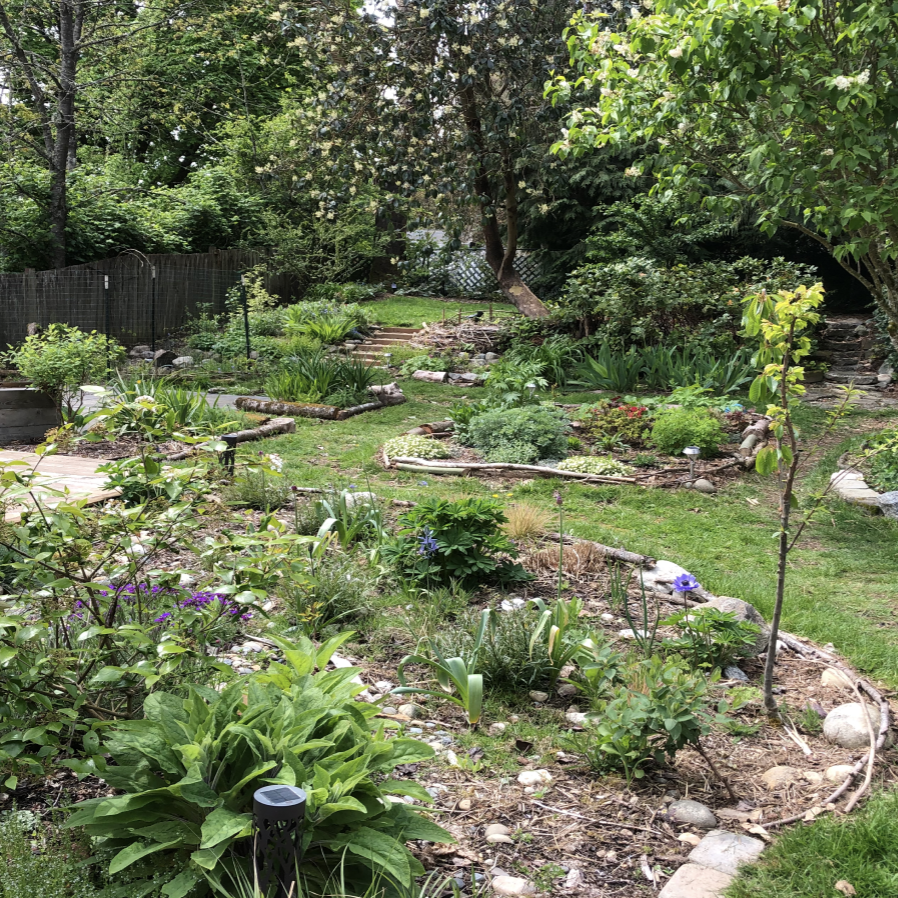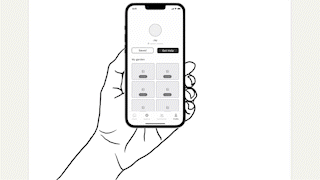
PatchWork is a tool to encourage pollinator growth through the power of gardening and community connection.
My Role
UX Designer, Researcher, & Creative Director.
My responsibilities included concept direction, facilitating communications with outside stakeholders, storyboarding, and desktop screen design.
My team and I collaborated on desk research, drafting interview agendas and scripts, facilitating interviews, data synthesis, ideation, visual design and mobile prototyping.
Team
Advised by Frog Design
Mikaela Corney
Dongming Liu
Nick Brown
Timeline
8 months:
January - August 2022
The Problem
Research shows that pollinator numbers are in decline. While small in size, pollinators are an essential part of our ecosystems and our food production. They are needed for the reproduction of 90% of flowering plants and one third of human food crops. Although bees may be the most famous, pollinators also include butterflies, moths, beetles, flies, birds, and bats among others.
Why Declination?
The Opportunity
One of the chief reasons for declination is destruction of pollinator habitat which reduces the number of available native food sources and overwintering spaces. Native plants are a key here because pollinators are adapted to feed and survive the winter on specific plant species, thus in turn many non-native plant species are ignored. Without their food and habitat sources, they can become malnourished, succumb to disease and die.
The opportunity is no further than our own backyards. The optimal foraging distance for pollinating insects is 1 mile or less. They need safe places to rest and refuel as they make their pollination rounds and by utilizing private properties and lawns as stepping stones, it could connect landscapes to allow for the free flow of species across a healthy area. By introducing native and diverse plants into plantable spaces, more habitat will be provided.
Meet PatchWork
PatchWork is a tool for collective action, where individuals can view their home garden as part of a connected urban landscape where ecological boundaries stretch beyond property lines. As part of PatchWork, members build relationships within their communities, learn to grow and maintain biodiverse gardens, and work together to connect fractured urban landscapes, one patch at a time.
The habitat map displays large-scale landscape connection and helps visitors visualize their place within the broader landscape. Click into an “opportunity area” to get recommendations on what to plant based on neighborhood data, or invite your neighbors to join the PatchWork community.
The Habitat Map
Utilizing Augmented Reality, gardeners can use pre-designed overlays to preview mature gardens in their space. There are four layers total - Bee, Bird, Butterfly and Moth - which will show different plants that support these species. We also included a timeline toggle which alters time states to preview how plants will look in different seasons and further years down the road.
Gardeners can tap into a plant to view more information about it and save it to their account.
AR Visualizer
When joining, members are invited to fill out a survey based on their goals, preferences and space. They will be connected to a PatchWork Master Gardener who will help them come up with a custom planting plan based on the survey.
A troubleshooting feature allows members to receive on-demand regional chat support, or schedule a video call whenever they need assistance in their garden journey.
Mentorship & Troubleshooting
PatchWork includes a community feature, where members can attend and host workshops. Share resources and tools is also made possible through a neighborhood sanctioned bulletin board.
Community Connection
How was it made?
Problem Statement
How might we help folks with plantable space encourage pollinator growth?
In taking inspiration from projects known as Pollinator Pathways by designer Sarah Bergmann and Professor Doug Tallamy’s Homegrown National Park, we wondered how we might be able to help people who have plantable space grow pollinator ecosystems to help stave off declination.
Research Questions:
How do homeowners consider pollinators when managing their plantable spaces?
What are the motivations for homeowners when considering pollinators in their plantable spaces?
What do homeowners do when managing their plantable spaces?
How does the broader community or landscape affect homeowners' consideration of their plantable spaces?
What are the opportunities for improving the process of creating and maintaining a plantable space for pollinators?

One study by NASA done in 2005 reported that there are over 40 million acres of grass lawn in the United States.

If homeowners dedicated even just 50% of their lawn space to re-introducing native and diverse plants, that would be 20 million acres to support pollinators.
Research Methods
Expert Interviews (60 Minutes)
We sought to recruit six experts from different backgrounds with unique perspectives on managing plantable space and pollinators. Our objective with these interviews was to help validate our initial desk research, and bring to light some information that would guide our questions and process for the next phase of our research (homeowner participant interviews).
Expert 1:
Caroline Villanova
Master Native Plant Steward
Caroline Villanova works for Mountains of Sound Greenway Trust. Her organization works with the forest service, land owners, cities, and tribes to help manage over 1.5 million acres of public lands in Washington.
Caroline’s broad experience working in Washington brought us a valuable local perspective on hands-on conservation best practices.
Expert 2:
Sarah Bergmann
Non-Profit Founder
Sarah Bergman is the founder of a non-profit called Pollinator Pathways. She started it as a way to redefine the relationship between people and the land they occupy, especially when it comes to natural infrastructure for pollinators.
Sarah’s holistic perspective highlighted our responsibility as humans to change the way we manage land.
Expert 3:
Gabe Lemay
Entomologist
Gabe Lemay does research at the University of Florida on Chemical Ecology, studying what kind of chemicals insects produce and how the manipulation of insect pheromones can be leveraged to help agriculture stakeholders and control invasive insect spread.
Gabe shed light on how insects, including pollinators, use chemicals to communicate and find food sources.
Expert 4:
Demarus Tevuk
Native Plant Expert and Non-Profit Board Member
Demarus is a board member of The Common Acre, a non-profit urban farm. With a strong background in traditional ecological knowledge, native pollinators, native plants, science, and engineering, Demarus’ research focuses on the definition of sustainability from the indigenous perspective.
Demarus highlighted how little data we have on native pollinators and explained that honeybees are often used as a greenwashing topic for companies.
Expert 5:
Richard Hartlage
Landscape Architect & CEO
Richard Hartlage is trained in horticulture and landscape architecture. He owns and manages a residential landscape firm called Land Morphology. He brought the perspective of a designer who creates with an artistic and aesthetic lens.
Richard’s experience designing and maintaining backyards helps us develop a more complex perspective of design for plantable spaces and the relationship to pollinators.
Expert 6:
Rye Ryan
Co-Owner & Operations Manager
Rye Ryan is the Operation Manager at Raintree Nursery, a unique nursery focusing on fruit trees and other consumables in Lewis Country, Washington. She is responsible for finances, customer service, and operations.
Rye provided invaluable insights into different customer profiles and the different needs of a novice vs. “extreme” gardener. Rye emphasized the importance of letting people discover at their own pace.
Even the smallest green space, like a flower box or curb strip, can be part of a pollinator pathway. -Sarah Bergmann
Participant Interviews
With the expert interviews completed, we formulated our plan for participant interviewing. Our objective was to recruit 10-12 homeowners from different areas around the city and from diverse backgrounds to maximize insights specific to the Seattle area. We recruited through social media, personal connections, and reaching out via University of Washington networks.
As a result, we interviewed 8 participants who gardened in an effort to help pollinators, and 2 who gardened without the explicit goal of helping pollinators.
Semi-Structured Interviews (90 Minutes)
The first part of our interview was a garden tour to build rapport and get a holistic overview for understanding the relationship they had with their gardens. During the tour, we’d ask questions around strategies for maintaining front and backyards, what activities they do, and what plants they’ve planted specifically for pollinators
The second part of our interview was a Journey Mapping activity. This would be used to collect rich details on each phase of the gardening process. Our goals were to gain perspective on the phases of planting, understanding areas of struggle, and uncover potential design opportunities. It also had the benefit of keeping participants engaged in the interview.
The activity was broken into 3 sections:
Learn about the phases of how homeowners plan and maintain their yards.
Learn about the specific techniques and tools they use during each phase of gardening.
Learn about the feelings associated with different phases. We encouraged participants to speak to their favorite and lease favorite phases.
Synthesis
Affinity Mapping
After the whole interview process was complete, we externalized our data onto sticky notes of a FigJam Board to do affinity diagramming. We began organizing data into different themes which led to the generation of insights. Some of our emerging themes were: performance anxiety, neighbors, learning from others, resources etc.

Affinity Mapping different participant data.

Organizing participant data into themes.
Insights
We formalized five main insights from synthesizing our data of ten participant sessions, six expert interviews, and our secondary desk research.
Insight 1
Trial and error must be part of the gardening process to help increase self confidence and learning.
Plants are living things so the stakes of failure felt higher to participants and error would be seen as unacceptable. Gardeners are also conscious of the wider community observing the progress being made on their yards which added an element of pressure in some cases.
Thus many of our participants felt like they needed to get it right the first time, and heavily weighed choices when getting started and committing to plans. We find that it’s critical to help gardeners understand that trial and error must be part of the process.
HMW build confidence in garden design and planting choices?
“With any projects like this I get intimidated and I stall at the beginning ... I’m not impulsive at all so if I’m going to do something, I like to do a lot of research before.”
Insight 2
Local expert knowledge helps to set parameters and provide personalized troubleshooting so gardeners are more likely to succeed in their choices.
Local experts resonate with homeowners since they understand the seasonality and climate of the region.
All participants sought local expertise through friends, nursery workers, and social media connections to gain more advice on plant selection and care. Unfortunately, many struggled to find mentors thorough the planting and maintenance process.
HMW make it easier for individuals to find and maintain trustworthy mentors?
“My coach ran a seed starting workshop in the spring. It was like, all my questions could be asked and it just gave me a lot more confidence in what I was doing. That’s really what it takes...Before I was just not sure... like ‘Am I doing this right?’”
Insight 3
Making a dream garden requires a balance between ability, time, money and knowledge and lacking these can be a barrier to entry.
Our participants were not afraid to dream big in the planning phase, however, there was a gap between the ideal garden and the gardener’s ability to carry out that plan. When it came down to choosing plants and getting their hands dirty, many participants ended up pairing down their plans to minimize time, money, or maintenance spent.
How we might be able to balance gardener expectations with the reality of the situation?
“[I should go to] Therapy so i’m not so hard on myself... My standards are higher than I am capable of doing.”
Insight 4
Growing and maintaining a garden builds social capital, encouraging an environment where information, inspiration and tools are more frequently shared between neighbors.
Participants focused on how the garden was a bridge for community building. Neighbors often shared tools, materials, and even plants with each other. Something that we heard form each participant , without fail, was they they would walk around the neighborhood to get inspired for their garden, or that they were gardening hoping to inspire their neighbors. Either way, the effect of a single garden appeared as something that was rarely isolated to one household.
HMW help facilitate resource and tool sharing between community members?
“I think it’s a community thing. You talk to people and find people you trust, like [my neighbor] two doors down...he’s always asking us ‘do you guys need compost?’”
Insight 5
The current narrative on pollinators, hyper focused on Honeybees, doesn’t tell the whole story.
Something that we hear from experts and then obseved in our participants was that there is a wide variety of understnading of pollinator ecosystems. With many of our participants there was a hyperfocus on the more famous pollinaotrs like the honey bee as a representative of the pollinator plight.
In order to create wholistic solutions to help pollinaotrs, the full spectrum of species and their needs must be part of the story.
HMW help people incorporate pollinators into their planning in an effort towards a larger, healthy ecosystem?
“There’s been more in the news lately because there’s been trouble with bees.”
Design Implications
Opportunity Areas
Gardening Planning and Forecasting
During the earlier phases, we imagine a tool that could help with the planning and forecasting would be super beneficial. Some participants mentioned they would love a planner that could guide them on when to take certain actions (like when to plant or when to water). Another wish we heard was for forecasting. Having a tool that could help gardeners envision what their tree could look like in 5 years and how it would impact the shade, or how big the blueberry bush was going to grow in a certain spot may facilitate easier planning.
Maintenance Help
In the maintenance phase, there was a general sense of frustration with some of the work that goes into it. For many participants, it was their least favorite part of the process. We’d be interested in exploring how we can help to ease the burden of maintenance or help people to better understand how much maintenance is required for certain plants or tasks (like watering). We could even try to help answer maintenance questions people had like “When is the right time to prune this plant?”
Community and Mentor Connection
During the preparation or planting phases, another opportunity is in local mentor and community connections. Many participants mentioned speaking with neighbors, visiting local nurseries, and attending classes to help them learn. Participants who had a consistent mentor or friend they could go to for troubleshooting seemed to have more success in their gardens and were more confident.
Information and Resource Sharing
During preparation and planning, gardeners traded information, plant seeds and starts, tools, soil, compost, branches, or other resources they needed. This was often done through Social Media or through neighbors. By helping to facilitate with this process, we may lower the barrier to entry for some gardeners, especially where finances are concerned.
Design Process
Design Principles
We chose the following design principles to guide us as we ideated and downselected. We wanted to ensure the following were included in the final product:
Keep Pollinators at the forefront.
Design a mutually beneficial tool for both gardeners and pollinators.
Connect the community to ease information and resource sharing, and help guide beginner gardeners to get more people started.
Capture data to visually display pollinator pathways and help gardeners understand where and how they can make the most impact.
Ideation
Concept Generation
Our insights informed a number of design directions for us. We each came up with 20 ideas, and began clustering them into different categories to help us better visualize potential solutions.
Distilling the main categories down further helped to inform the main elements we wanted for our design concept. I imagined a platform which would be comprised of three main sections: Discovery & Connection, Planning & Learning, and the Neighborhood Ecosystem Data Visualization, which would serve as the landing page and home page.
Downselection
Storyboarding as Rapid Prototyping
We initially had difficulty narrowing down to only one feature idea. We decided the product could incorporate a couple features into it, as long as we were careful not to overwhelm the outcome. We used storyboarding to imagine the user journey, with a limited number of frames for highlighting key interactions. Storyboarding as a whole really helped us to focus on the key moments, prioritize, and agree on a baseline together as a team for what we wanted to accomplish.
I drew the final storyboard, pictured below, which would serve as the guide for our concept video, and confirm the exact screens we would need to prototype:
Information Architecture
When it came to designing screens, I suggested we first draft up some information architecture for both mobile and desktop versions of PatchWork to act as the source of truth on where all our features would be sorted as we design. Pictured below is the architecture for our desktop version:
Visual System
From the logo to color selection, biomimicry was used as inspiration for the choices.
The logo itself needed to be simple, and was derived from pollinator, flower, and clover shapes as well as symbiosis imagery representing connection to the land and to one another.
Our colors were chosen to be reminiscent of gardening, while also communicating a bright, friendly side of our brand. I considered accessibility here, and ran our colors through a checker to ensure the color and size would be legible to people of varying visual abilities.
For fonts, we chose Arboria and Work Sans. We agreed on these due to their modern look, their ease to read, and their functionality as they offered a multitude of different weights. Since our final product included printed material, it was important that these typefaces and colors work well for both printed material and digital spaces.
Additionally, I created all of our system components for desktop and mobile to ensure our product’s consistency.
Reflections
Takeaways
Pollinator declination is just a piece of broader systemic issues surrounding our relationship to the land. From uncontrolled burning of fossil fuels, to linear waste systems and over extraction of our forests and fisheries, so much of what we do today relies on a disconnect. While a backyard garden may seem inconsequential from these other bigger systemic issues, we believe that what begins in the garden doesn’t end there. PatchWork uses the garden and pollinator health as a leverage point in creating a future where individuals view themselves as a part of, rather than apart from the landscape.
What would I do with more time?
Given more time, I would love to do further research and testing, especially where it concerns information architecture. I would suggest a card sorting activity to ensure the organization makes sense and is logical for our gardeners to navigate and find the information they need.
When thinking about how PatchWork could scale, I believe it would start regionally in Seattle as it is the origin place of our research, before spreading to different cities and around the world. I would love to explore ways to expand and support more property types (such as farms, commercial buildings etc) and I also like to imagine ways of connecting with different organizations like non-profits, local nurseries, and small businesses.
Ensuring the site has an emphasis on renters just as much as home owners would also be key. As many of our initial features shown here are geared towards beginner gardeners, an additional opportunity for us is to explore further ways to appeal to those experienced gardeners joining PatchWork and ensure there are features that appeal towards their needs.


















































